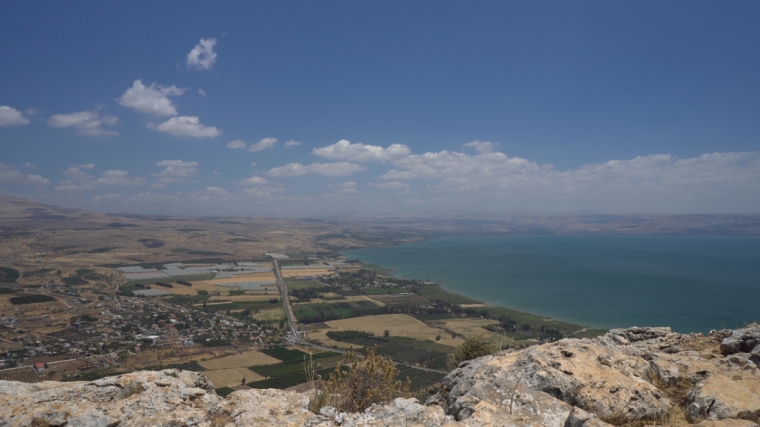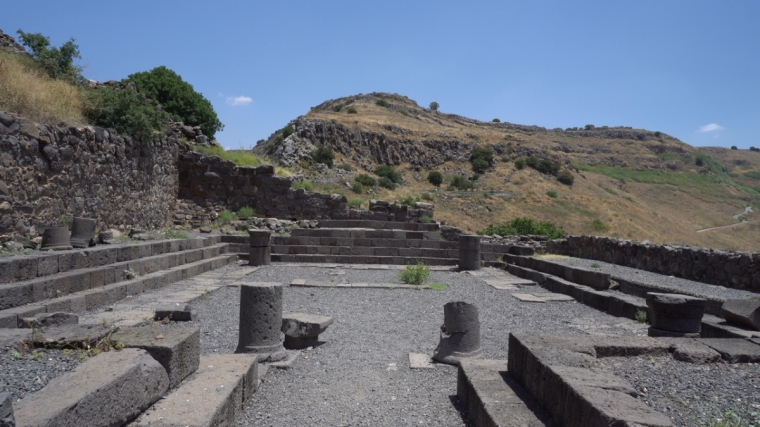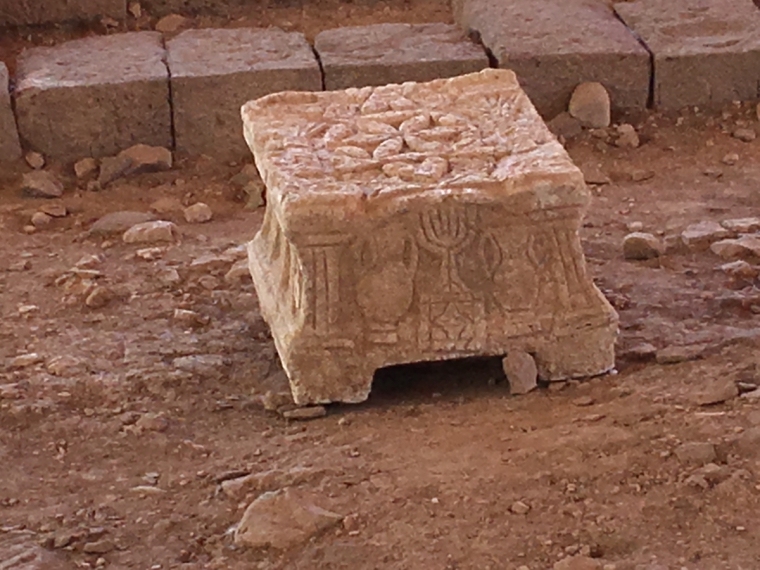THROUGH THE BIBLE: The synagogues of Magdala and Gamla; was Jesus here?

Christian Examiner continues a new series which allows readers to walk with Dr. Eric Mitchell, Associate Professor of Old Testament & Biblical Archaeology at Southwestern Baptist Theological Seminary, through some of the most important sites in the Bible. Mitchell directs the archaeological survey at Tel Gezer. Mitchell's journal entries will help readers visualize important sites like Gezer, the places where Jesus walked, and the valley where David killed the Philistine Goliath.
GAMLA, Israel (Christian Examiner) – The Gospel accounts highlight the teachings and miracles of Jesus of Nazareth.
Much of His ministry was set near the Sea of Galilee with Capernaum as His base.
Many of His twelve disciples came from this region. Peter, Andrew, James, John, and Phillip were from Bethsaida. Matthew and Peter were from Capernaum, where we are told Peter had a house.
Many from Galilee and the surrounding regions sought out Jesus to hear His teaching and see – or experience firsthand – His miraculous power.
We know little of Jesus's early life – only that He was an obedient son and that He was very knowledgeable about the Hebrew Scriptures (see Luke 2:41 and following). However, the Gospels present detailed accounts about His ministry during the last three years of His earthly life.
Being born between 6 and 4 B.C., it was around A.D. 30 that Jesus laid aside His carpentry tools and began His public ministry (in his mid- to late-thirties).
After His baptism by John and time of temptation in the Wilderness of Judea, Jesus returned to His hometown of Nazareth.
It was there, in the local synagogue of His youth, that He began His formal teaching ministry with His pronouncement about the Year of Jubilee having arrived (see Luke 4:16 and following, as well as Isaiah 61:1).

Each synagogue was a place of assembly for prayer, Scripture reading, teaching, worship, and biblical study in Jewish towns. As an institution, the synagogue may have come about during the Babylonian exile, when the Jews no longer had access to the Temple after its destruction (see Ezekiel 11:16).
A precursor to the synagogue may be first mentioned in Psalm 74:8 where they are called "meeting places," though there is no archaeological evidence of them before the Hellenistic period (or the time following Alexander the Great's conquest of the Ancient Near East).
The Gospel of Mark indicates that it was Jesus's custom to teach on the Sabbath in the local synagogues (see Mark 1:21; 6:1-5; Luke 4:15 and following; John 18:20), and many synagogues are mentioned in Paul's missionary travels across the Roman world as well (see Acts 13-15).
A typical synagogue of the first century A.D. was not large. The one at Gamla was built of basalt stone, and likely had a wooden roof. It had four rows of columns and there were benches around the walls for seating. The men and women sat separately.
Just outside the front entry was a ritual bath (or mikveh) which was used by worshippers to purify themselves through immersion before entry.
There was a small study room at the back of the synagogue. The Scriptures were kept in an "ark" (likely a movable cabinet) inside the central door near the Seat of Moses (see below).

Each synagogue had an official who was in charge (see Mark 5:22; Matthew 9:18; Luke 13:10ff) and an attendant/helper (as in Luke 4:20).
The synagogue official was most likely a learned man, perhaps a Scribe or Pharisee trained by a prominent rabbi, who studied the Scriptures regularly and who should have authoritatively known the Scriptures.
The teacher for the day would sit in a raised seat called the "Seat of Moses" located right by the entrance in what would today be the back of the room. Nearby would be located the bema (or pulpit) for reading the Scriptures. The best seats in the synagogue were near where the teacher sat.
The synagogue attendant would bring the assigned scroll reading to the teacher/synagogue official. The teacher would stand to read the passage and, when finished reading, would give the scroll back to the attendant. Then he would sit to teach and expound upon the passage.
Each Sabbath it was typical to read a passage from the Law of Moses (Genesis to Deuteronomy) including Israel's statement of faith in Deuteronomy 6:4-9 (vs 4 "Hear, O Israel! The Lord is our God, the Lord is one!") and perhaps also from another passage (see Acts 15:21).
At times, a synagogue "official/ruler" could serve a judicial role. He would sometimes chastise, beat, or excommunicate one in the community who broke the Law of Moses (see John 9:22; 12:42; 16:2). Paul admits to doing these things to many Christians before his conversion (see Acts 22:19 and 26:11).
Jesus indicates in the gospels that these synagogue officials are "scribes" who wear long robes and love to sit in the chief seat (that is, the Seat of Moses as in Luke 20:46 and following, and Matthew 23:6).
Jesus warned His followers against these scribes who would arrest, try, and beat them in the synagogues for His sake (See Matthew 10:17, 23:34; Mark 13:9; and Luke 4:29, 12:11 and 21:12).
Jesus's teaching amazed the Jews for, unlike the scribes, He taught with authority (see Mark 1:22).

Why are these places so important for the study of the Bible?
Each Sabbath it was Jesus's custom to teach/preach and perform miracles (healing and casting out demons) in the local synagogue (see Luke 4:16 and John 18:20). He taught in many synagogues in the cities and villages across the land but the regions of Galilee and Judea are specifically mentioned (see Mark 1:39 and Luke 4:44).
According to Matthew 9:35, Jesus was traveling through all the cities and villages teaching in synagogues. Matthew 4:23 states, "Jesus was going throughout all Galilee, teaching in their synagogues and proclaiming the gospel of the kingdom, and healing every kind of disease and every kind of sickness among the people" (see also Mark 1:21).
There are seven known first century A.D. synagogues in the and. Two of these, Gamla and Magdala, are excellent examples. Out of all of these, the oldest is the one at Magdala (dated 50 B.C.-A.D. 68).
Both Gamla and Magdala are within walking distance of Jesus base of ministry at Capernaum on the northern shore of the Sea of Galilee.
Gamla was a Jewish city on a camelback shaped hill up a valley northeast of, and with a distant view of, the Sea of Galilee.
Located in the modern Golan Heights, Gamla was in the territory of Herod Phillip and northeast of Kursi, where Jesus healed the Gadarene demoniac (see Matthew 8:28). Gamla was later destroyed by the Roman general (and later emperor) Titus in the revolt of A.D. 69-70. Gamla was excavated by Shmarya Guttman and Danny Syon on behalf of the Israeli Department of Antiquities.

Magdala was on the western shore of the Sea of Galilee. The hometown of Mary Magdalene, it was located on the plain of Ginnesar (Gennesaret) about five miles from Capernaum. Magdala was on the road from Capernaum to Nazareth. Luke 8:2 indicates that Jesus cast out seven demons from Mary Magdalene. It is unknown where this took place, but Jesus did cast out demons in his synagogue teaching visits (see Mark 1:21 and following and 1:39; see also Luke 4:33).
Recent excavations at Magdala have located a Jewish synagogue, port, and settlement there dated to the first century B.C. The excavations were directed by archaeologists Dina Avshalom-Gorni and Arfan Najar of the Israel Antiquities Authority, and were sponsored by the Universidad Anáhuac México Sur (Anahuac University of Mexico – South in partnership with Universidad Nacional Autónoma de México (National Autonomous University of Mexico – UNAM) and the Israel Antiquities Authority.

The synagogue at Magdala has several mosaic tile surfaces, remains of painted plaster frescoes, and one of the significant finds was a carved ornamental stone (perhaps a bema?) with an image of a seven-branched Menorah (candelabra) in between two pillars – symbols which may represent the second Temple in Jerusalem.
Mark 8:10 states that after feeding the 4000, Jesus visited the district of Dalmanutha—which is now understood to be about five hundred meters north of Magdala.
Even if He did not teach in the synagogue at Magdala at that time, it would be surprising if he did not do so at some point in His ministry. This would be due to its close proximity both to Jesus's base of ministry, and it being on the road which He would have often taken through the region.
Dr. Eric Mitchell covers Bible Backgrounds for the Christian Examiner. He is Associate professor of Old Testament & Archaeology at Southwestern Baptist Theological Seminary in Fort Worth, Texas, and directs Mitchell directs the archaeological survey at Tel Gezer.